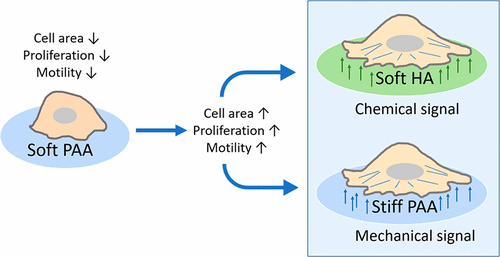当前位置:
X-MOL 学术
›
Biomacromolecules
›
论文详情
Our official English website, www.x-mol.net, welcomes your feedback! (Note: you will need to create a separate account there.)
Soft Substrates Containing Hyaluronan Mimic the Effects of Increased Stiffness on Morphology, Motility, and Proliferation of Glioma Cells
Biomacromolecules ( IF 6.2 ) Pub Date : 2017-09-14 00:00:00 , DOI: 10.1021/acs.biomac.7b00324 Katarzyna Pogoda 1, 2 , Robert Bucki 1, 3 , Fitzroy J. Byfield 1 , Katrina Cruz 1 , Tongkeun Lee 1 , Cezary Marcinkiewicz 4 , Paul A. Janmey 1, 5
Biomacromolecules ( IF 6.2 ) Pub Date : 2017-09-14 00:00:00 , DOI: 10.1021/acs.biomac.7b00324 Katarzyna Pogoda 1, 2 , Robert Bucki 1, 3 , Fitzroy J. Byfield 1 , Katrina Cruz 1 , Tongkeun Lee 1 , Cezary Marcinkiewicz 4 , Paul A. Janmey 1, 5
Affiliation

|
Unlike many other cancer cells that grow in tumors characterized by an abnormally stiff collagen-enriched stroma, glioma cells proliferate and migrate in the much softer environment of the brain, which generally lacks the filamentous protein matrix characteristic of breast, liver, colorectal, and other types of cancer. Glial cell-derived tumors and the cells derived from them are highly heterogeneous and variable in their mechanical properties, their response to treatments, and their properties in vitro. Some glioma samples are stiffer than normal brain when measured ex vivo, but even those that are soft in vitro stiffen after deformation by pressure gradients that arise in the tumor environment in vivo. Such mechanical differences can strongly alter the phenotype of cultured glioma cells. Alternatively, chemical signaling might elicit the same phenotype as increased stiffness by activating intracellular messengers common to both initial stimuli. In this study the responses of three different human glioma cell lines to changes in substrate stiffness are compared with their responses on very soft substrates composed of a combination of hyaluronic acid and a specific integrin ligand, either laminin or collagen I. By quantifying cell morphology, stiffness, motility, proliferation, and secretion of the cytokine IL-8, glioma cell responses to increased stiffness are shown to be nearly identically elicited by substrates containing hyaluronic acid, even in the absence of increased stiffness. PI3-kinase activity was required for the response to hyaluronan but not to stiffness. This outcome suggests that hyaluronic acid can trigger the same cellular response, as can be obtained by mechanical force transduced from a stiff environment, and demonstrates that chemical and mechanical features of the tumor microenvironment can achieve equivalent reactions in cancer cells.
中文翻译:

含有透明质酸的软底物模仿了增加的刚度对胶质瘤细胞的形态,运动性和增殖的影响
与许多其他以癌细胞为特征的异常生长的肿瘤不同,这些肿瘤的特征是异常僵硬的胶原蛋白丰富的基质,神经胶质瘤细胞在较柔软的大脑环境中增殖和迁移,而大脑通常缺乏乳房,肝脏,结肠直肠和其他组织的丝状蛋白质基质特性。癌症类型。胶质细胞源性肿瘤及其衍生的细胞异质性很高,其机械性能,对治疗的反应以及体外性能各不相同。当离体测量时,某些神经胶质瘤样品比正常脑部更硬,但即使是体外柔软的那些,也因体内肿瘤环境中出现的压力梯度而变形后也变硬。这种机械差异可以强烈改变培养的神经胶质瘤细胞的表型。或者,通过激活两种初始刺激所共有的细胞内信使,化学信号传导可能会引起与刚性增加相同的表型。在这项研究中,我们将三种不同的人类神经胶质瘤细胞系对基质硬度变化的反应与它们在由透明质酸和特定的整联蛋白配体(层粘连蛋白或胶原蛋白I的组合)组成的非常柔软的基质上的反应进行了比较。通过量化细胞形态,刚度,运动性,增殖和细胞因子IL-8的分泌,胶质瘤细胞对刚度增加的反应显示,即使不增加刚度,含透明质酸的底物也几乎完全相同。PI3激酶活性是必需的,以响应透明质酸而不是刚性。
更新日期:2017-09-15
中文翻译:

含有透明质酸的软底物模仿了增加的刚度对胶质瘤细胞的形态,运动性和增殖的影响
与许多其他以癌细胞为特征的异常生长的肿瘤不同,这些肿瘤的特征是异常僵硬的胶原蛋白丰富的基质,神经胶质瘤细胞在较柔软的大脑环境中增殖和迁移,而大脑通常缺乏乳房,肝脏,结肠直肠和其他组织的丝状蛋白质基质特性。癌症类型。胶质细胞源性肿瘤及其衍生的细胞异质性很高,其机械性能,对治疗的反应以及体外性能各不相同。当离体测量时,某些神经胶质瘤样品比正常脑部更硬,但即使是体外柔软的那些,也因体内肿瘤环境中出现的压力梯度而变形后也变硬。这种机械差异可以强烈改变培养的神经胶质瘤细胞的表型。或者,通过激活两种初始刺激所共有的细胞内信使,化学信号传导可能会引起与刚性增加相同的表型。在这项研究中,我们将三种不同的人类神经胶质瘤细胞系对基质硬度变化的反应与它们在由透明质酸和特定的整联蛋白配体(层粘连蛋白或胶原蛋白I的组合)组成的非常柔软的基质上的反应进行了比较。通过量化细胞形态,刚度,运动性,增殖和细胞因子IL-8的分泌,胶质瘤细胞对刚度增加的反应显示,即使不增加刚度,含透明质酸的底物也几乎完全相同。PI3激酶活性是必需的,以响应透明质酸而不是刚性。



























 京公网安备 11010802027423号
京公网安备 11010802027423号